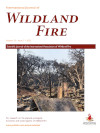
International Journal of Wildland Fire
Volume 32 Number 7 2023
WF22229Making choices: prioritising the protection of biodiversity in wildfires
 , Phillipa C. McCormack
, Phillipa C. McCormack  , Jan McDonald
, Jan McDonald  , Sarah Legge
, Sarah Legge  , Stephen T. Garnett
, Stephen T. Garnett  , Brendan Wintle
, Brendan Wintle  and Libby Rumpff
and Libby Rumpff 
Wildfires can kill people, destroy infrastructure and impose significant impacts on biodiversity – including, in extreme cases, extinction. Decision makers must make fateful choices during emergencies about what to try to protect. Conventionally, biodiversity assets are rated relatively low in such decision-making. We argue that this should not be the case.
WF22229 Abstract | WF22229 Full Text | WF22229PDF (1.1 MB) Open Access Article
WF22155Drivers of California’s changing wildfires: a state-of-the-knowledge synthesis
 , Erica Fleishman, Alexander Gershunov, Molly Hunter, Rachel A. Loehman, Phillip J. van Mantgem, Beth Rose Middleton, Hugh D. Safford, Mark W. Schwartz and Valerie Trouet
, Erica Fleishman, Alexander Gershunov, Molly Hunter, Rachel A. Loehman, Phillip J. van Mantgem, Beth Rose Middleton, Hugh D. Safford, Mark W. Schwartz and Valerie Trouet
To aid in the preparation for increasing wildfire risks, the objective of this manuscript is to synthesise and assess the current state of knowledge and inform the broader community of researchers, managers, and the public about the multifaceted and geographically variable nature of the ongoing wildfire challenges in California.
WF22155 Abstract | WF22155 Full Text | WF22155PDF (3 MB) Open Access Article
Peatlands in Australia are vulnerable to climate-driven degradation. One peatland experienced a loss of 3.46 t of carbon in the 3 months following fire and rain events. Fire and erosion potentially increase peatland nutrient exports. Ground studies are required to develop and verify landscape-scale carbon budgets.
WF22204 Abstract | WF22204 Full Text | WF22204PDF (4.4 MB) Open Access Article
The widespread impacts on terrestrial and aquatic environments after wildfires is an important and understudied area of research. Following a large wildfire in British Columbia, this study found elevated concentrations of polycyclic aromatic hydrocarbons, potentially toxic compounds, in burned soils and sediments in an ecologically important and sensitive river system.
WF22211 Abstract | WF22211 Full Text | WF22211PDF (4.2 MB) | WF22211Supplementary Material (173 KB) Open Access Article
WF22001Fire and habitat variables explain reptile community abundance and richness in subtropical open eucalypt forests
Reptile communities exposed to unique fire regimes were assessed to determine their responses to time since fire, frequency, fire type and habitat structure. Fire parameters were significant predictors of reptile abundance, with higher frequencies negatively affecting overall abundance. Reptile richness and specific species favoured top disposal burn sites.
WF22023Effects of a large wildfire on the community composition of medium and large mammals in a neotropical savannah
We assessed the effects of a large unplanned wildfire on medium and large mammals in a neotropical savannah (Cerrado), with pre-fire sampling in burned and unburned areas, recording 25 species in burned areas and 19 in unburned areas, with clear changes in the community up to 3 years after burning.
WF22192Shoot flammability patterns among plant species of the wildland–urban interface in the fire-prone Greater Blue Mountains World Heritage Area
Urban exotic plants were less flammable than wildland and urban native plants at the wildland–urban interface of the Greater Blue Mountains World Heritage Area, eastern Australia. Shoot traits including fuel moisture, bulk density and volume were significant drivers of variation in shoot flammability.
WF22192 Abstract | WF22192 Full Text | WF22192PDF (3.7 MB) | WF22192Supplementary Material (1.2 MB) Open Access Article
WF22096Effect of flame zone depth on the correlation of flame length with fireline intensity
Correlations of flame length with fireline intensity have suggested that the depth of the flaming zone could be neglected. New laboratory experiments are reported showing flame zone depth substantially reduces measured flame length. This occurs because entrainment and combustion are greater within deep flame zones compared to the original theory.
WF22096 Abstract | WF22096 Full Text | WF22096PDF (2.9 MB) Open Access Article
WF22209Regional estimation of dead fuel moisture content in southwest China based on a practical process-based model
Process-based models for estimating dead fuel moisture content can involve extensive computational time to process long time-series data with multiple iterations. In this study, we provided a more time-efficient method to run a previously established process-based model and applied it to Pinus yunnanensis forests in southwest China.
WF22172A comparison of smoke modelling tools used to mitigate air quality impacts from prescribed burning
We compared three smoke modelling tools commonly used to plan prescribed burning projects (the Simple Smoke Screening Tool, VSmoke and HYSPLIT) by modelling smoke dispersion from a year of operational burns. The differences among the tools are significant and inconsistent. Tool improvements and clear guidelines for applying predictions are needed.
WF22172 Abstract | WF22172 Full Text | WF22172PDF (2.7 MB) | WF22172Supplementary Material (1.3 MB) Open Access Article



